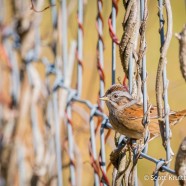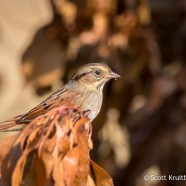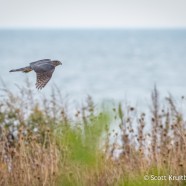Swamp Sparrow
Are you on the fence about going outdoors this weekend? Just do it! Listen to the Swamp Sparrow and enjoy some fresh air.
Read MoreSwamp Sparrow
Swamp Sparrows can sometimes be difficult to photograph, but no one told this bird that it was not supposed to be captured this way! Those brush piles can be very productive at this time of year. Make sure to have one or two in your yard this winter, especially if you have bird feeders nearby. They provide cover and a great photographic opportunity.
Read MoreCooper’s Hawk
I have been posting many photos of migrant songbirds lately, and here is one of their predators – the Cooper’s Hawk (Accipiter cooperii). This raptor of the forest is an extremely agile and talented flier, able to navigate through thick woodlands in pursuit of prey. You may recognize them from your yard as they are frequent bird feeder guests, targeting hungry passerines. They seem to be less adept at capturing prey in open areas like this one, unable to fully utilize their maneuverability and relative speed as they do in more dense habitat to surprise and outwit songbirds. This...
Read MoreSwamp Sparrow
This Swamp Sparrow (Melospiza georgiana) was one of several that I enjoyed seeing this past Monday as the species moves through wet, grassy habitats on the way south. Autumn migration is in constant motion this week with a moderate flight nearly every night. You’ll end up seeing some of the same little faces every day with a few news ones sprinkled in. This upcoming Sunday looks like it may be a terrific day to be outside for us and for the birds. What could be better than walking outdoors and enjoying lovely little creatures like this one? Scott Kruitbosch Conservation & Outreach...
Read MoreRadar Migration October 1, 2015
Here is an impressive view of the eastern United States just after midnight today, October 1, 2015. The precipitation we can see south of New England over the ocean and into the Mid-Atlantic and south is from a cold front that passed through yesterday and is now nearly stationary. It allowed migrant birds to take to the air on subsequent strong northerly winds. However, this front will creep back to the west, and we do not yet know what Hurricane Joaquin will do to the east coast. It will most likely thread the needle between an Atlantic high and a coastal low, moving into the Mid-Atlantic...
Read More








